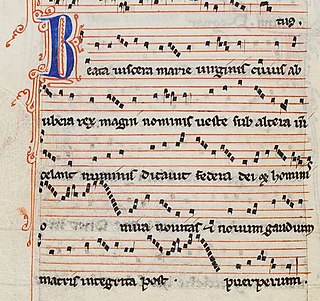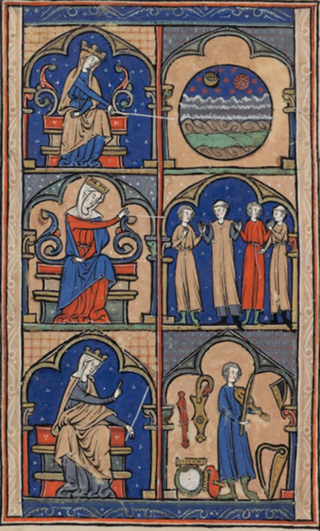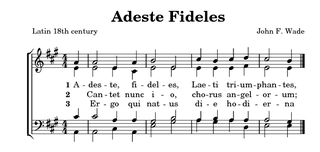
Medieval music encompasses the sacred and secular music of Western Europe during the Middle Ages, from approximately the 6th to 15th centuries. It is the first and longest major era of Western classical music and is followed by the Renaissance music; the two eras comprise what musicologists generally term as early music, preceding the common practice period. Following the traditional division of the Middle Ages, medieval music can be divided into Early (500–1000), High (1000–1300), and Late (1300–1400) medieval music.

A clef is a musical symbol used to indicate which notes are represented by the lines and spaces on a musical staff. Placing a clef on a staff assigns a particular pitch to one of the five lines or four spaces, which defines the pitches on the remaining lines and spaces.

In music, monophony is the simplest of musical textures, consisting of a melody, typically sung by a single singer or played by a single instrument player without accompanying harmony or chords. Many folk songs and traditional songs are monophonic. A melody is also considered to be monophonic if a group of singers sings the same melody together at the unison or with the same melody notes duplicated at the octave. If an entire melody is played by two or more instruments or sung by a choir with a fixed interval, such as a perfect fifth, it is also said to be monophony. The musical texture of a song or musical piece is determined by assessing whether varying components are used, such as an accompaniment part or polyphonic melody lines.
Pérotin was a composer associated with the Notre Dame school of polyphony in Paris and the broader ars antiqua musical style of high medieval music. He is credited with developing the polyphonic practices of his predecessor Léonin, with the introduction of three and four-part harmonies.
Organum is, in general, a plainchant melody with at least one added voice to enhance the harmony, developed in the Middle Ages. Depending on the mode and form of the chant, a supporting bass line may be sung on the same text, the melody may be followed in parallel motion, or a combination of both of these techniques may be employed. As no real independent second voice exists, this is a form of heterophony. In its earliest stages, organum involved two musical voices: a Gregorian chant melody, and the same melody transposed by a consonant interval, usually a perfect fifth or fourth. In these cases the composition often began and ended on a unison, the added voice keeping to the initial tone until the first part has reached a fifth or fourth, from where both voices proceeded in parallel harmony, with the reverse process at the end. Organum was originally improvised; while one singer performed a notated melody, another singer—singing "by ear"—provided the unnotated second melody. Over time, composers began to write added parts that were not just simple transpositions, thus creating true polyphony.

Isorhythm is a musical technique using a repeating rhythmic pattern, called a talea, in at least one voice part throughout a composition. Taleae are typically applied to one or more melodic patterns of pitches or colores, which may be of the same or a different length from the talea.
Léonin was the first known significant composer of polyphonic organum. He was probably French, probably lived and worked in Paris at the Notre Dame Cathedral and was the earliest member of the Notre Dame school of polyphony and the ars antiqua style who is known by name. The name Léonin is derived from "Leoninus", which is the Latin diminutive of the name Leo; therefore it is likely that Léonin's given French name was Léo.
The clausula was a newly composed section of discant inserted into a pre-existing setting of organum. Clausulae flourished in the late twelfth and thirteenth centuries and were associated with the Notre Dame school. The origin of the clausula has long been subject of scholarly debate, as the relationship between clausulae and motets is very complicated. Clausulae eventually became used as substitutes for passages of original plainchant. They occur as melismatic figures based on a single word or syllable within an organum.

The conductus was a sacred Latin song in the Middle Ages, one whose poetry and music were newly composed. It is non-liturgical since its Latin lyric borrows little from previous chants. The conductus was northern French equivalent of the versus, which flourished in Aquitaine. It was originally found in the twelfth-century Aquitanian repertories. But major collections of conducti were preserved in Paris. The conductus typically includes one, two, or three voices. A small number of the conducti are for four voices. Stylistically, the conductus is a type of discant. Its form can be strophic or through-composed form. The genre flourished from the early twelfth century to the middle of thirteenth century. It was one of the principal types of vocal composition of the ars antiqua period of medieval music history.

In medieval music, the rhythmic modes were set patterns of long and short durations. The value of each note is not determined by the form of the written note, but rather by its position within a group of notes written as a single figure called a ligature, and by the position of the ligature relative to other ligatures. Modal notation was developed by the composers of the Notre Dame school from 1170 to 1250, replacing the even and unmeasured rhythm of early polyphony and plainchant with patterns based on the metric feet of classical poetry, and was the first step towards the development of modern mensural notation. The rhythmic modes of Notre Dame Polyphony were the first coherent system of rhythmic notation developed in Western music since antiquity.

The Magnus Liber or Magnus liber organi, written in Latin, is a repertory of medieval music known as organum. This collection of organum survives today in three major manuscripts. This repertoire was in use by the Notre-Dame school composers working in Paris around the end of the twelfth and beginning of the thirteenth centuries, though it is well agreed upon by scholars that Leonin contributed a bulk of the organum in the repertoire. This large body of repertoire is known from references to a "magnum volumen" by Johannes de Garlandia and to a "Magnus liber organi de graduali et antiphonario pro servitio divino" by the English music theorist known as Anonymous IV. Today it is known only from later manuscripts containing compositions named in Anonymous IV's description. The Magnus Liber is regarded as one of the earliest collections of polyphony.
Fauxbourdon – French for false drone – is a technique of musical harmonisation used in the late Middle Ages and early Renaissance, particularly by composers of the Burgundian School. Guillaume Dufay was a prominent practitioner of the form, and may have been its inventor. The homophony and mostly parallel harmony allows the text of the mostly liturgical lyrics to be understood clearly.
France has a rich music history that was already prominent in Europe as far back as the 10th century. French music originated as a unified style in medieval times, focusing around the Notre-Dame school of composers. This group developed the motet, a specific musical composition. Notable in the high Middle Ages were the troubadours and trouvères soon began touring France, composing and performing many original songs. The styles of ars nova and ars subtilior sprung up in the 14th century, both of which focused on secular songs. As Europe moved into the Renaissance age, the music of France evolved in sophistication. The popularity of French music in the rest of Europe declined slightly, yet the popular chanson and the old motet were further developed during this time. The epicenter of French music moved from Paris to Burgundy, as it followed the Burgundian School of composers. During the Baroque period, music was simplified and restricted due to Calvinist influence. The air de cour then became the primary style of French music, as it was secular and preferred by the royal court.
Falsobordone is a style of recitation found in music from the 15th to the 18th centuries. Most often associated with the harmonization of Gregorian psalm tones, it is based on root position triads and is first known to have appeared in southern Europe in the 1480s.
The Saint Martial School was a medieval school of music composition centered in the Abbey of Saint Martial, Limoges, France. Most active from the 9th to 12th centuries, some scholars describe its practices, music, and manuscripts as 'Aquitanian'. It is known for the composition of tropes, sequences, and early organum. In this respect, it was an important precursor to the Notre Dame School. Adémar de Chabannes and his nephew Roger de Chabannes were important proponents of this school whose hands had only be recently discovered by studies of James Grier between 1995 and 2005. They invented a local variant of a vertically precise organisation of notation and a new form of local tonary, they reorganised existing chant manuscripts, and they developed the libellum structure of a new type of sequentiary troper whose organisation was new at their time, but played a key role for the Saint Martial school.

A paraphrase mass is a musical setting of the Ordinary of the Mass that uses as its basis an elaborated version of a cantus firmus, typically chosen from plainsong or some other sacred source. It was a common means of mass composition from the late 15th century until the end of the 16th century, during the Renaissance period in music history, and was most frequently used by composers in the parts of western Europe which remained under the direct control of the Roman Catholic Church. It is distinguished from the other types of mass composition, including cyclic mass, parody, canon, soggetto cavato, free composition, and mixtures of these techniques.

A hymn tune is the melody of a musical composition to which a hymn text is sung. Musically speaking, a hymn is generally understood to have four-part harmony, a fast harmonic rhythm, with or without refrain or chorus.
With regard to early polyphony the term copula has a variety of meanings. At its most basic level, it can be thought of as the linking of notes together to form a melody. "A copula is a rapid, connected discant..." However, it is often considered to be a particular type of polyphonic texture similar to organum, but with modal rhythm. The music theorist Johannes de Garlandia favoured this description of copula. The term refers to music where the lower voice sings long, sustained notes while the higher voices sing faster-moving harmony lines. This style is typical of what is referred to as Notre Dame Polyphony; examples of which can be found in the Magnus Liber Organi. Copula might have implied a strophic construction with much repetition in the various parts, which was characteristic of much of the music written in this idiom. The upper part consists of "antecedent-consequent" phrases, themselves featuring much melodic repetition. The rhythm is notated in copula, unlike in organum. It is, in essence, the "coming together" of these two parts at the cadence that led to the term copula being used, from the Latin meaning "that binds."
1st millennium BC in music – 1st millennium in music – 11th century in music
The Latin word quintus, also quinta or quinta vox, refers to the fifth voice in addition to the superius, altus, tenor and bassus in a piece of vocal polyphony. In Baroque vocal music, this fifth voice was added to the principal part and then given to the tenor. The word was particularly used for printed partbooks of five-voice music, where the "quintus" melody might well be for different voices like the discantus or even the contratenor, in addition to the usual four.










